Ledebouria genus
Ledebouria Roth
Family: Hyacinthaceae
Common names: African hyacinth, ledebouria, common squill.
Introduction
The genus Ledebouria was described in 1821 by Roth, although the history of the genus dates back even further, with several authors placing it in other genera. The oldest record of these is by Linnaeus the Younger (abbreviated "L.f."), from 1782, who placed it in the genus Hyacinthus (Venter 1993). The genus is well represented in Southern Africa, with 39 species (Venter 2008) occurring in South Africa.

Description
Description
The genus Ledebouria is a group of bulbous plants with variously spotted, textured and coloured leaves ranging from minute novelties to large leafy plants well suited to the garden. Plants in this genus typically produce rosettes of leaves which may vary in number from one to several leaves, usually densely to sparsely spotted or plain; the leaves of some species are textured with pustules, pits or hairs and may be various shades of green or otherwise coloured. The characteristically small flowers are produced on loose unbranched racemes and vary in colour from bright lilac to deep pink or purple but can also be green or yellowish green and usually exhibit a central green stripe down each petal.
Conservation Status
Status
Several Ledebouria species are exposed to different degrees of threat, principally caused by habitat loss due to human activities such as agriculture, urbanization and afforestation (commercial forestry). Some species are naturally rare and only known from a limited region, such as L. parvifolia, while others occur in areas which are subject to development pressure which reduces the available habitat for the species, such as L. coriacea.
According to the latest Red Data List for South Africa the following species are listed as threatened:
Ledebouria atrobrunnea - Vulnerable
Ledebouria cremnophila - Rare
Ledebouria crispa - Endangered
Ledebouria dolomiticola - Vulnerable
Ledebouria galpinii - Endangered
Ledebouria lepida - Rare
Ledebouria mokobulanensis - Vulnerable
Ledebouria parvifolia - Data deficient
Several species have not yet been assessed for this list and may be included once assessments have been concluded.
Distribution and habitat
Distribution description
The genus is distributed mainly across sub-Saharan Africa with a few species in Madagascar and India. The centre of diversity of the genus is located in the northeastern and eastern parts of southern Africa (Venter 2008) with the highest number of species occurring in the summer rainfall regions and only a few recorded from the southern and western parts of the country.
Derivation of name and historical aspects
History
The genus is named after Carl Friedrich von Ledebour (1785-1851) who was a German-Estonian botanist. He was professor of science at the University of Tartu, Estonia from 1811-1836. He is noted for important works, including Flora Altaica, the first Flora of the Altay Mountains, published in 1833, and Flora Rossica, published in four volumes between 1841 and 1853, the first complete flora of the Russian Empire. New species he described for the first time in the Flora Altaica include Malus sieversii (as Pyrus sieversii), which is the wild ancestor of the apple, as well as the Siberian Larch Larix sibirica.
Ecology
Ecology
Seed dispersal is principally by water (rain-wash) which washes the seed away from where it was released by the mother plant.
Little is known about the specific pollination of this group of plants, but the floral structure suggests that pollination can be effected by any visiting insect. Venter (1993) speculates that the main pollinators may be social bees as well as honey bees.
The spotted leaves, which are especially common in this genus, are thought to be associated with camouflage against insect herbivory (Prof. A.E. van Wyk, pers. comm.). Several species show unique ecological adaptations while others are adapted to specific niches which they occupy. Examples of these include: Ledebouria viscosa which has sticky leaves, causing sand grains to adhere to the leaf surface, presumably making the leaves less appealing to browsing herbivores. L. marginata has copious amounts of tough fibres in the leaf tissue which is presumably also associated with herbivory reduction.
L. hypoxidioides has densely hairy leaves. This may be a case of mimicry where the plant mimics a sympatric (co-occurring) but unrelated Hypoxis species. Alternatively it could also be associated with insect herbivory or reduction of moisture loss.
Porcupines excavate and eat the bulbs of several ledebourias.
Uses
Use
Ledebouria has been cited as being used for medicinal purposes, including pregnancy, diarrhoea, influenza, backache, skin irritations, wounds and lumbago (Long 2005). The genus is also reputed to be poisonous in Africa, although it is reported that bushmen eat the bulbs of L. apertiflora and L. revoluta ( Pfosser & Speta 2001).
Growing Ledebouria genus
Grow
Ledebouria socialis, which is natural to the Eastern Cape Province, is well known in cultivation around the world as a curious pot plant with its bulbs exposed above ground level and its silvery-spotted leaves that are often bright purple on the underside.
Members of this genus are seldom grown as garden plants, probably as their flowers are not very striking. However, some of the larger species such as L. zebrina and L. floribunda have attractive foliage and can be used to good effect in grassland or meadow gardens, or planted amongst rocks and boulders in succulent rockeries. Many of the smaller species such as L. cooperi, L. galpinii, and L. rupestris make attractive container specimens, where their brightly coloured flowers and curiously adorned leaves can best be appreciated.
Members of this genus are generally easily cultivated and are best raised from seed sown at the beginning of their growing season and then planted out into open ground or containers, once they reach a suitable size. Most species can be raised from seed to flowering size in about three years. They generally prefer full sun and a well-drained soil with adequate water in the warm summer growing season, and a dry resting period during the cool dry winter. Some species are adapted to hot arid regions; these should be given less water and may need to be kept in a glass house in cooler and wetter climates.
Propagation can also be done using other methods such as division, and in some species by leaf cuttings or using bulb regeneration techniques.
AcknowledgementsJohn Leroy is thanked for photo editing. Dr Matt Buys is thanked for editing the manuscript.
Species

L. apertiflora prefers rather hot and semi-arid areas of southern Africa where it occurs in hot dry woodland or scrub in gravelly soil. The large seeds are possibly an adaptation to aid the survival of the seedlings in the dry and inhospitable environment.
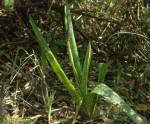
L. floribunda can vary in size and the larger of these variants can possess leaves reaching 500 mm high. The flower spikes are characterized by the high number of flowers on the inflorescence which can often reach one hundred or more. The attractively marked leaves make this species an interesting/worthwhile addition to the garden where it can be grown in full sun or dappled shade.
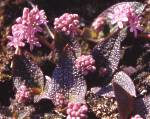
L. galpinii is a mist belt species which is restricted to a very small area in the high mountains of the Mpumalanga Province. This species is characterized by the glossy purple-brown pitted leaves and brightly coloured flowers which make for an attractive pot plant display when they are in full flower in early spring.
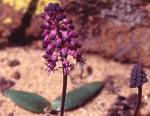
L. lepida is a dwarf species which occurs in a small area in the Waterberg in the Limpopo Province.
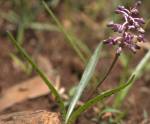
L. minima is one of the dwarf species and is extremely cryptic when not in flower in amongst the grasses. This species flowers in spring and can only be spotted easily when the grass has been burnt during the previous winter period. These conditions often result in this species flowering en-masse after the onset of the spring rains in certain areas where it can be quite abundant in small pockets.
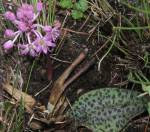
L. mokubalanensis, a recently named species, occupies a specific habitat in the mountainous regions of the Mpumalanga Province. The attractive green leaves are adorned with sunken red pits and the brightly coloured flowers make an attractive show, albeit quite subtle.
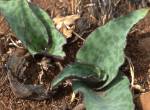
L. ovatifolia is characterized by the leaves which are tightly appresssed to the soil surface and broadly triangular in shape. This species is very widespread and displays a wide variation with several local forms. It would warrant a separate study to determine if some of these forms are not separate species. The upper leaf surface is variously marked with dense to sparse purple or dark green spots or is totally unspotted.

L. remifolia is a curious and quite rare species. Obscured by taxonomic misplacement for many years, it has now been resurrected to species level. The leaves are curious in the genus as they produce long leaf stalks which present small glossy leaf-like projections at their apex. This species is mostly restricted to a very small site inside the Blyde River Nature Reserve in the Mpumalanga Province.

L. revoluta is one of the most widespread and common species in the genus; it is also one of the most variable, and many different forms of this species can be seen across a vast area of the eastern part of southern Africa.

L. sandersonii is a widespread and variable species which occurs mostly in the northern regions of South Africa. The flowers of this species are often brightly coloured and make a handsome display. This species prefers seepage areas, usually in high-lying grassland but can also be found amongst rocks and in other habitats.
References
- Germishuizen, G. & Meyer, N.L. (eds). 2003. Plants of southern Africa. Strelitzia 14. National Botanical Institute, Pretoria.
- Venter, S. 2008. Synopsis of the genus Ledebouria Roth (Hyacinthaceae) in South Africa. Herbertia 62.
- website: http://en.wikipedia.org/wiki/Carl_Friedrich_von_Ledebour
- website: Long, C. (compiler) 2005. Swaziland 's Flora - siSwati Names and uses http://www.sntc.org.sz/flora/clusagelist.asp?uid=2&pg=29
- website: Pfosser, Martin and Franz Speta. 2001. Hyacinthaceae. Hyacinthus, Ornithogalum, Scilla and their relatives. Version 01 January 2001 (under construction). h ttp://tolweb.org/Hyacinthaceae/21437/2001.01.01 in The Tree of Life Web Project, http://tolweb.org/
- website: The National Red List of South African Plants (March 2009): http://www.sanbi.org/biodiversity/reddata.htm
Credits
Andrew Hankey
Walter Sisulu National Botanical Garden
July 2011
Plant Attributes:
Plant Type: Bulb
SA Distribution:
Soil type: Sandy, Clay, Loam
Flowering season: Spring, Early Summer
PH: Neutral
Flower colour: Green, Pink, Cream
Aspect: Full Sun
Gardening skill: Easy
Special Features:
Horticultural zones











Rate this article
Article well written and informative
Rate this plant
Is this an interesting plant?
Login to add your Comment
Back to topNot registered yet? Click here to register.